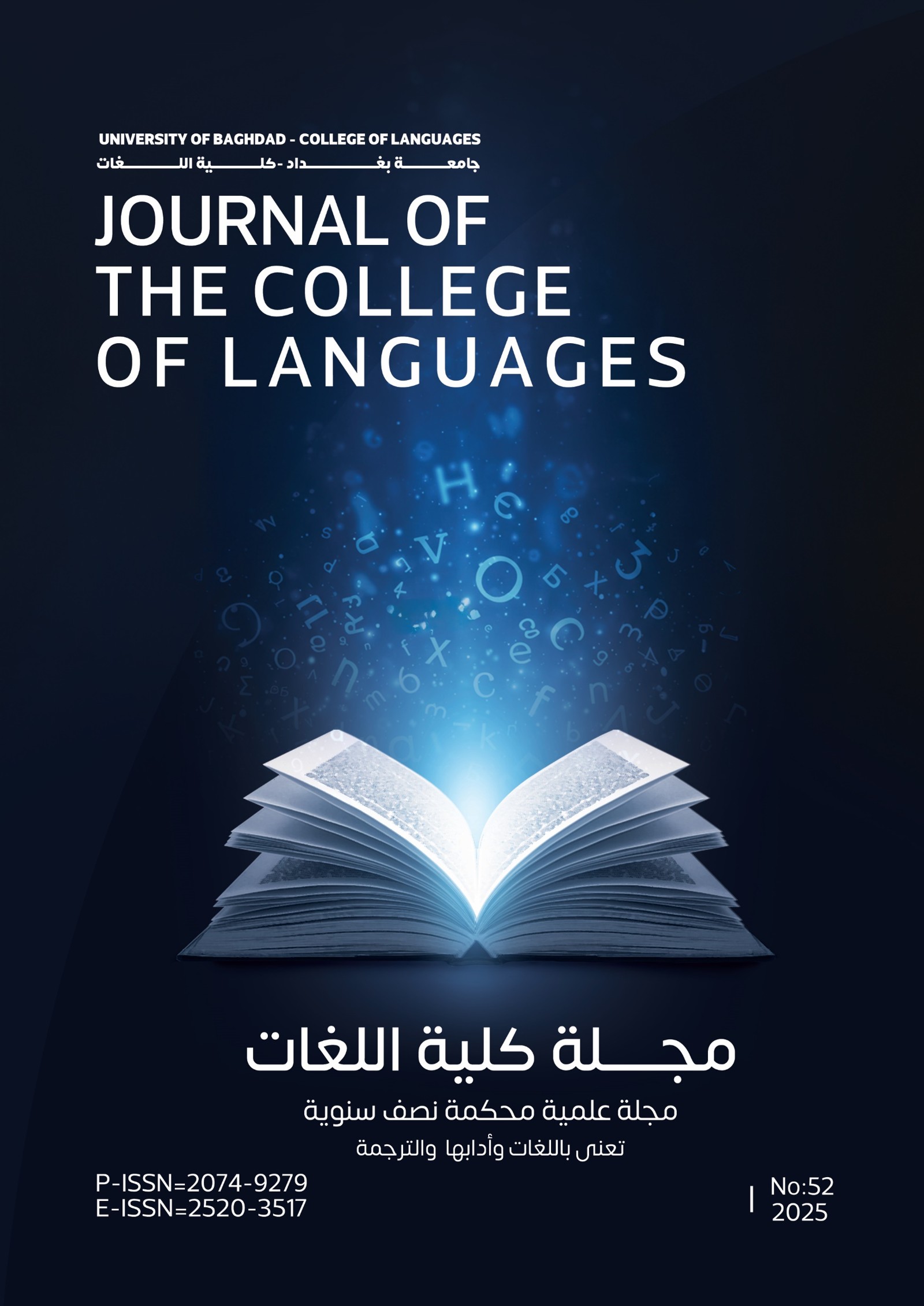A Feminist Discourse Analysis of Writer's Gender Biases about Violence Against Women
DOI:
https://doi.org/10.36586/jcl.2.2021.0.44.0021Keywords:
gender, prejudice, bias, Feminism, CDAAbstract
The present study is concerned with the writer's ideologies towards violence against women. The study focuses on analyzing violence against women in English novel to see the extent the writers are being affected and influenced by their genders. It also focuses on showing to what extent the writer's ideologies are reflected in their works. Gender influences social groups ideologies; therefore, when a writer discusses an issue that concerns the other gender, they will be either subjective or objective depending on the degree of influence, i.e., gender has influenced their thoughts as well as behaviors. A single fact may be presented differently by different writers depending on the range of affectedness by ideologies. The study aims to uncover the hidden gender-based ideologies by analyzing the discursive structure of a novel based on Van Dijk's model (2000) of ideology and racism. The selected novel is based on discussing violence against women. The study will later on reveal the real writer’s gender-based ideologies and whether the writer is a feminist or an anti-feminist? Or Is he prejudiced? Or Is he biased?

This work is licensed under a Creative Commons Attribution 4.0 International License.
( Received on 11/10/2020 - Accepted on 8/11/2020 - Published on 1/6/2021 )
References
- Baugh, J., (2000). Beyond Ebonics: Linguistic pride and racial prejudice. New York: Oxford University Press.
- Baxter, J. (2003). Positioning gender in discourse: a feminist research methodology. Paper presented at the British Educational Research Association Annual Conference, Heriot-Watt University, Edinburgh, 11-13 September 2003.
- Bloor, M., & Bloor T. (2007). The practice of critical discourse analysis: An Introduction. Hodder Arnold.
- Brannon, L. (2000), Gender Stereotypes: Masculinity and Femininity [interactive]. Available at: http://www.ablongman.com/partners_in_psych/PDFs/Brannon/Brannon_ch07.pdf.
- Bressler, C. E. (2011). Literary Criticism: An Introduction to Theory and Practice (A Second Printing) (5th Edition). Boston : Pearson Longman, ©2011.
- Cameron, D. (1992). Feminism and linguistic theory (2nd addition). Published by the Macmillan press Ltd.
- Cameron, D. (2005). Language, gender and sexuality: current issues and new directions‘, Applied Linguistics 26 (4), 2005:482-502.
- Dijk, T. (2014). Discourse and Knowledge: A Sociocognitive Approach. Cambridge: Cambridge University Press.
- Eagly, A. H., Nater, C., Miller, D. I., Kaufmann, M., & Sczesny, S. (2019, July 18). Gender Stereotypes Have Changed: A Cross-Temporal Meta-Analysis of U.S. Public Opinion Polls From 1946 to 2018. American Psychologist. Advance online publication. http://dx.doi.org/10.1037/amp0000494.
- Fairclough, N. (1995). Critical discourse analysis: The critical study of language. London: Longman.
- Fiske, S. T., & Lee, T. L. (2008). Stereotypes and prejudice create workplace discrimination. In A. P. Brief (Ed.), Diversity at work (pp. 13–52).
- Jackson, L. M. (2011). The psychology of prejudice: From attitudes to social action. Washington, DC: American Psychological Association.
- Karlberg, Michael. (2005). The Power of Discourse and the Discourse of Power: Pursuing Peace through Discourse Intervention. 10.
- Lazar, M. (2005). Politicizing Gender in Discourse: Feminist Critical Discourse Analysis as Political Perspective and Praxis. 10.1057/9780230599901_1.
- Majstorović, D., Lassen, I. (2011). John Benjamins Publishing Company Amsterdam/Philadelphia.
- Mills, S. (1995). Feminist stylistics. London: Routledge.
- Office of the United Nations High Commission for Human Rights.(2014). Gender stereotypes and Stereotyping and women’s rights. https://www.ohchr.org/documents/issues/women/wrgs/onepagers/gender_stereotyping.pdf.
- Paltrige, B. (2006). Discourse Analysis. By MPG books Ltd, Bodmin, Cornwall.
- Rahimi, A., & Sahragard, R. Critical discourse analysis. Shiraz University. Jungle publication.
- Schiffrin, D., Tannen, D., & Hamilton, H. E. (2003). The handbook of discourse analysis. Malden, Mass: Blackwell Publishers.
- Shapiro, J., Neuberg, S. (2007). From Stereotype Threat to Stereotype Threats: Implications of a Multi-Threat Framework for Causes, Moderators, Mediators, Consequences, and Interventions. Personality and social psychology review : an official journal of the Society for Personality and Social Psychology, Inc. 11. 107-30. 10.1177/1088868306294790.
- Sunderland, J. (2006). Language and gender: An advanced resource book. London & New York: Routledge.
- Tilley, Elspeth. (2007). Feminist Discourse Analysis. 10.1002/9781405165518.wbeos1098.
- Turner, B. S. (2006). The Cambridge dictionary of sociology. Cambridge [England: Cambridge University Press.
- van Dijk, T. A. (1998). Ideology: A multidisciplinary approach. Sage Publications, Inc.
- Weber, M., Roth, G., & Wittich, C. (1978). Economy and society: An outline of interpretive sociology. Berkeley: University of California Press.
- Weedon, C. (1987). Feminist practice and poststructuralist theory. Oxford, UK: B. Blackwell.
- Wiggins B. E. (2019). The Discursive Power of Memes in Digital Culture: Ideology, Semiotics, and Intertextuality. 1 Edition. New York: Routledge.
- Wood, W., & Eagly, A. H. (2010). Gender. In S. T. Fiske, D. T. Gilbert, & G. Lindzey (Eds.), Handbook of social psychology (5th ed., Vol. 1, pp. 629–667). Hoboken, NJ: John Wiley & Sons.
- Wood, W., Christensen, P. N., Hebl, M. R., & Rothgerber, H. (1997). Conformity to sex-typed norms, affect, and the self-concept. Journal of Personality and Social Psychology, 73(3), 523–535. https://doi.org/10.1037/0022-3514.73.3.523.
- Zhang, S., Schmader, T., & Forbes, C. (2009). The effects of gender stereotypes on women’s career choice: Opening the glass door. In M. Barreto, M. K. Ryan, & M. T. Schmitt (Eds.), The glass ceiling in the 21st century: Understanding barriers to gender equality (pp. 125–150).
- نظرة للدراسات النسوية (كاتب الدليل هند محمود - شيماء طنطاوي)،تحرير (مزن حسن - أمل المهندس)،المراجعة اللغوية ( أحمد الدريني) مارس ٢٠١٦.








